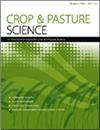水分亏缺条件下腐殖酸和黄腐酸对豇豆形态生理生化特性的影响
IF 1.9
4区 农林科学
Q2 AGRICULTURE, MULTIDISCIPLINARY
引用次数: 0
摘要
水分缺乏是豇豆(Vigna unguiculata)生产性能的一个限制因素。腐植酸和黄腐酸是提高植物生产力的有机肥料,是在缺水条件下提高豇豆生产力的可行选择。目的研究腐殖酸和黄腐酸对水分亏缺豇豆形态生理生化特性的影响。方法在温室内进行试验。在5×2因子方案中采用完全随机设计,4个重复,分别以100%和25%的农田容量灌溉植株,施用5个剂量的腐殖酸和黄腐酸,分别为0,4,8,12和16mL/L。气孔导度(gs)、水势(Pw)、株高(H)、茎粗(SD)、叶片数(NL)、根瘤数(NR)、地上鲜重和干重(FMA和DMA)、根系鲜重和干重(FMR和DMR)、总可溶性蛋白(SP)和总酚类化合物(PC)。8和12mL/L剂量使应激和非应激个体的gs (100 - 200mmm2s−1)增加,Pw (- 0.9MPa)和NR降低,FMR和DMR(20和10g)增加,SP (8 - 9g)增加。结论干旱地区豇豆生产推荐使用中等剂量的腐植酸和黄腐酸(12mL/L)。结论腐植酸和黄腐酸是半干旱区农业生产和决策优化的可行选择。本文章由计算机程序翻译,如有差异,请以英文原文为准。
Humic and fulvic acid influence the morphophysiological and biochemical properties of cowpea (Vigna unguiculata) under water deficit
Context Water deficit is a limiting factor in cowpea (Vigna unguiculata) performance. Humic and fulvic acids are organic fertilisers that increase plant productivity and appear as a viable alternative to improve cowpea productivity under water deficit.Aim We evaluated the efficiency of humic and fulvic acid on the morphophysiological and biochemical properties of cowpea subjected to water deficit.Methods The experiment was conducted in a greenhouse. A completely randomised design was adopted in a 5×2 factorial scheme with four replications, with five doses of humic and fulvic acid, 0, 4, 8, 12 and 16mL/L applied to plants irrigated at 100% and 25% of field capacity. Stomatal conductance (gs), water potential (Pw), plant height (H), stem diameter (SD), number of leaves (NL), number of root nodules (NR), fresh and dry weight of the aerial (FMA and DMA) and root (FMR and DMR), total soluble proteins (SP) and total phenolic compounds (PC).Key results Doses of 8 and 12mL/L increased gs (100–200mmolm2s−1), reduced Pw (−0.9MPa) and NR, increased FMR and DMR (20 and 10g), SP (8–9g) in stressed and non-stressed individuals.Conclusions Intermediate doses of humic and fulvic acid (12mL/L) are recommended for cowpea production in dry regions.Implications Humic and fulvic acid together are viable alternatives for optimising agricultural production and decision making in semi-arid regions.
求助全文
通过发布文献求助,成功后即可免费获取论文全文。
去求助
来源期刊

Crop & Pasture Science
AGRICULTURE, MULTIDISCIPLINARY-
CiteScore
4.20
自引率
15.80%
发文量
111
审稿时长
3 months
期刊介绍:
Crop and Pasture Science (formerly known as Australian Journal of Agricultural Research) is an international journal publishing outcomes of strategic research in crop and pasture sciences and the sustainability of farming systems. The primary focus is broad-scale cereals, grain legumes, oilseeds and pastures. Articles are encouraged that advance understanding in plant-based agricultural systems through the use of well-defined and original aims designed to test a hypothesis, innovative and rigorous experimental design, and strong interpretation. The journal embraces experimental approaches from molecular level to whole systems, and the research must present novel findings and progress the science of agriculture.
Crop and Pasture Science is read by agricultural scientists and plant biologists, industry, administrators, policy-makers, and others with an interest in the challenges and opportunities facing world agricultural production.
Crop and Pasture Science is published with the endorsement of the Commonwealth Scientific and Industrial Research Organisation (CSIRO) and the Australian Academy of Science.
 求助内容:
求助内容: 应助结果提醒方式:
应助结果提醒方式:


